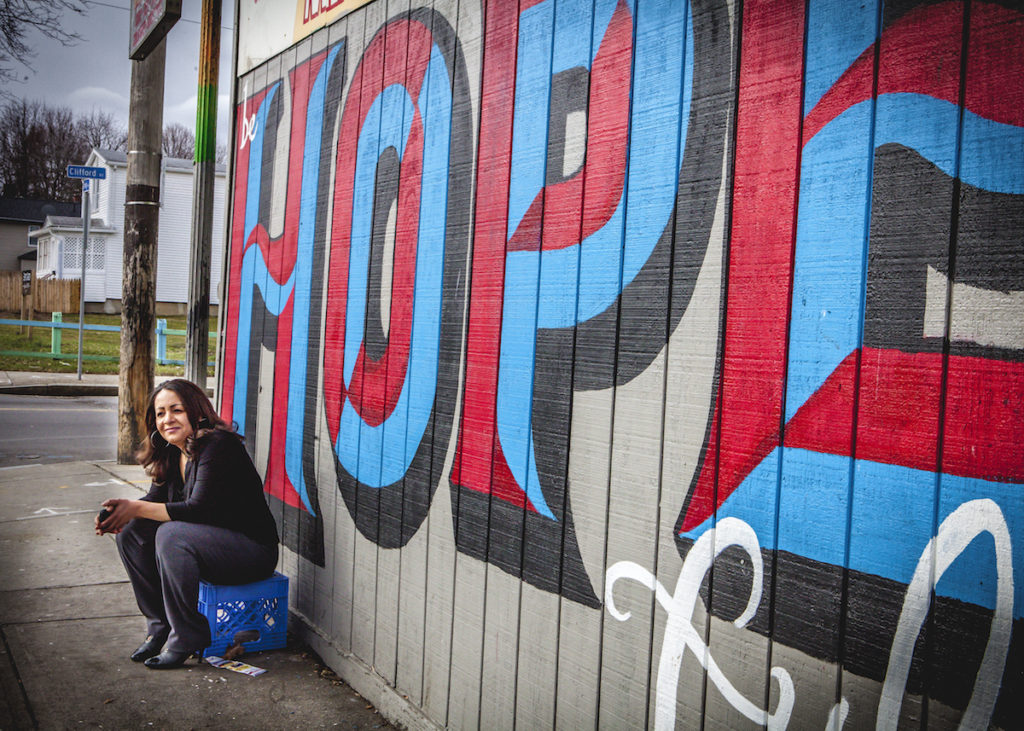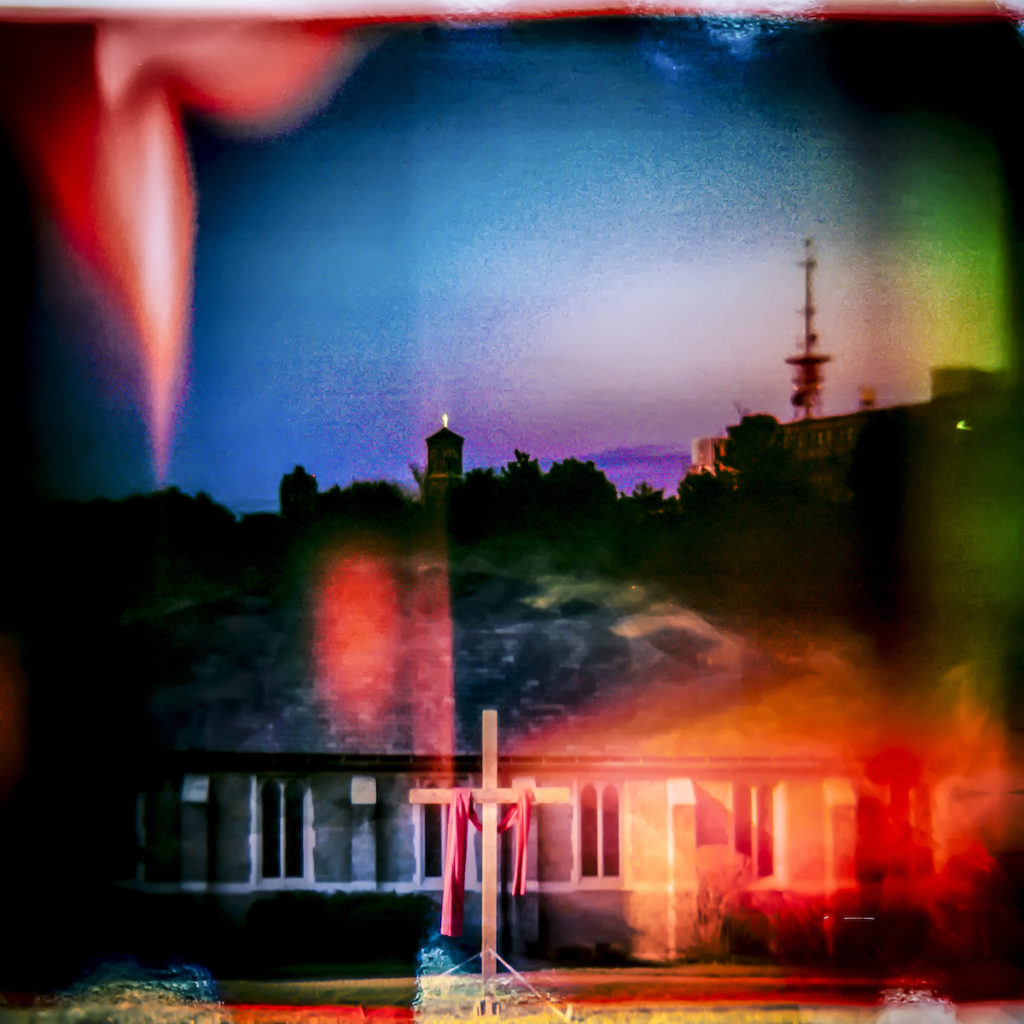Hope City: Teens Find Extraordinary Common Ground with Images of Hope

Portraits by Takako/The Hope Is Project, Holga photo by Dan Mason/The Hope Is Project
Traumatized teens and centers of influence find extraordinary common ground with images of hope
Behind a wolf mask. In an empty theater. On the roof of a stadium.
In April 2016, Sarah Takako Skinner, founder of The Hope Is Project, flew from Seattle to New York City. She hopped in a rental car with her business partner/producer Marc Raco and they made the six-hour drive to Raco’s hometown, Rochester, NY. Sitting at the edge of Lake Ontario, Rochester was once known as “The Flour City” for it’s flour mills, then as “The Flower City” for it’s internationally renowned abundance of lilacs and other blooms. As the birthplace of Eastman Kodak and all that George Eastman brought to the world of image-making, the moniker “The World’s Image Center” is also ultimately fair.
The Hope Is Project explores the power and nature of hope via an artful process, which combines the mentoring of people with compelling stories of adversity to look for evidence of hope and photograph it (creating in sum a kind of remarkable self portrait) with evocative portraits of the participant by Skinner herself. The inside is seen on the outside, and the outside shows what is on the inside. Together, these two approaches tell a participant’s story and invariably result in a kind of transformation and an increased level of hopefulness.
Villa of Hope, a Rochester-based child and family service agency providing care to traumatized and challenged teens and their families, had recently changed its identity despite a long and substantial history in the community. When Vice President of Development and Marketing Gerianne Puskas got wind of the project, it didn’t take long for the prospect of collaboration to percolate. There is the need to drive their identity into community consciousness as caretakers of hope, along with (despite boasting a vibrant artistic, scenic and medical research quotient amongst other attributes) once-invincible Rochester’s need to rise from the drain and pain of growing violence, poverty and substance abuse (Rochester has been ranked in the top five U.S. cities for poverty).
Add in the embedded significance of photography on both sides of city lines and there was proof enough that there must be something to yield from bridging that gap. After an initial conversation revealed how such an initiative could offer the possibility of a tool that could contribute to actual therapeutic impact on some of the teens, a plan was in motion.
Three teens from Villa of Hope would be given the opportunity to work with The Hope Is Project team. And, to demonstrate that the search for hope is universal, three influential adults from the Rochester area, all representing different corners of local society, would also participate and allow us to see hope through their eyes.
As our team arrived in the city of Rochester, the very first sign they saw was a banner covering the side of a building. It contained a single word: “Hope.” Before they had even arrived at their destination, they had seen two more similar signs. The city was calling out.
For now, they would start with six of its people. First, the “influencers”.
Angie Perez, Vice President with the Villa of Hope team, who is an active member of Rochester’s desperately needed anti-poverty initiative and who herself has overcome a difficult start in life to become a community leader and activist; Pam Sherman, an affluent suburban columnist and consultant who has called for a change in the community discourse; and Dan Mason, the philanthropy-minded general manager of the city’s popular minor league baseball team, The Rochester Red Wings.
Then there were the teens. Stories of their pasts are difficult to hear; yet their yearning for a hopeful future is just as crucial to their continued growth and progress.
Eighteen year old Cyonna points to her father’s prison time and mother’s neglect as causes for her countless instances of running away, one time to another city sixty miles away. She’s worn inmate orange and seen truly tough times. Now, she’s headed towards college and living in an apartment made possible by Villa of Hope (many of her Holga photos of hope are of the apartment grounds), being creative and embracing new opportunities and challenges. She easily shared her story and jumped into the process. When posing for portraits, she dove in voraciously and modeled with the ease of a pro and with professional spirit. In the course of just two hours, her business-like cooperativeness switched into wide smiles and playfulness as she fell into the experience that welcomed her. From the outside, she seems cautiously ever more sure of herself as she notes her progress and it intuits a bright future for her. In fact, at the 2016 Villa of Hope “Portraits of Hope Gala”, Cyonna was presented a scholarship to attend the local community college. A vote of confidence, and another offering of hope.
Also eighteen, Adrian carries a bravado which appears to shield a past that may have yielded a thick armor of distrust and need to control most situations. Yet his energy, willingness to take charge and command his path all fold away like a house of cards when a situation has any loose footing. He did not smile for a single photograph, yet was engaged with the process. He even provided inspiration for one of the most touching moments of the experience. Adrian has revealed his deep love of acting and desire to pursue it. Project producer Raco, also a professional actor, mobilized his local theater connections to make a dream come true with a once–in-a–lifetime experience for the teen.
When Adrian was told a highly respected local theatre would be opened for an hour just for him to play and create and perform, with essentially a run of the house from stage to dressing room, from costumes to full lighting, tears of joy wasted no time. The next morning, he strutted and sang a Broadway song about being comfortable with oneself, recited a monologue he already had in his head, and posed for Skinner’s portraits. He was buoyant and relaxed and seemed untethered, basking in the glow of something magnificent which had happened, and which was about others doing something all about him for once. This moment mattered.
Then there was the fourteen year old, who we’ll call “Celeste”, betrayed by those she loved and trusted and forced into a world no child should have to live in. Her anonymity was mandatory because of the things she has witnessed in her life. Villa of Hope staff worked feverishly the prior afternoon accomplishing a “Hail Mary” approval from all of the many people, agencies and governmental departments necessary to give the official nod to Celeste’s participation, and determine it would not undermine her protection or progress. Skinner had brought a few masks with the help of a staff member of Villa of Hope — Wonder Woman, The Phantom of the Opera, a Power Ranger, and a wolf — so Celeste could be photographed freely, and have another way to express herself, without revealing her identity.

Initially, Celeste was timid, quiet, barely uttering a word. Her wary, side-eyed looks spoke volumes. How could someone who had learned to survive by trusting no one be willing to open herself up to strangers, assume a photographic assignment and participate openly in a mere matter of hours? Skinner talked with her gently, giving her the chance to choose from the masks, showing her how to use the Holga camera and to load the film. The task of teaching the use of film was a challenge in itself, as most fourteen year olds have never seen a real film camera, much less used one.
She also shocked Skinner and Raco by completing an entire roll of film with her Holga camera in one day. While not an easy path, and filled with resistance, Celeste’s portrait session with Skinner was like watching someone unfold, like a kite being let out slowly into the breeze, becoming freer and dancing more with each inch of trust it is given. Bit by bit she became more animated and more invested in each idea, each setup, each experience.
A particularly poignant moment came when she actually took control of one setup, suggesting what she would do and where she would be positioned. It was like watching a child crawl and try to stand over and over again. Then, in one moment, they are up, and taking their first steps. She was still raw with the experiences she has endured, and there were rocky moments as the session progressed. That single moment was the only which mattered.
The fact that the adults were no longer children, and they held status and stations in the community, did not provide invulnerability to impact and transformation.
Perez was the most reserved when introduced, yet shared the most about her personal journey and accomplishments. She often speaks, mentors and inspires publicly, sharing her story of determination to rise from a childhood consumed by drug abuse and poverty to a meaningful and productive life of helping others, successful parenting and economic health.

Sherman’s first reaction was to laugh. After all, what business did an affluent, white woman from the best part of town have to assume she had something to say, or share, about hope? She instantly doubted the relevance of her participation in the project, but she had committed to going through with it, and wasn’t a quitter, so she might as well make the most of it. The Hope Is Project team was invited to her impressively decorated home and she posed dutifully in front a piano she didn’t play, and positioned on a window seat in a way that didn’t display what was on the “inside.”
The most surprising moment of connection seemed to come from Mason. Skinner and Raco first sat with Mason, Sherman, Perez and Puskas in the offices of The Red Wings, the Minnesota Twins’ farm team and long-time AAA baseball team. As general manager, and a pillar of the community, Mason invited the group to assemble on his turf on the basis of pure trust in Puskas and her organization. It turned out that he didn’t actually know what would be asked of him in detail. It was quickly evident when he learned more that he was having a “What have I gotten myself into?” moment, expressing repeatedly that he did not have confidence in his photography skills to capture acceptable photographs, much less those effectively portraying such a lofty premise as hope. When Skinner offered some examples of the types of images participants might capture, the group noted a visible change in Mason, who had been clearly looking uncomfortable.
Suddenly, as if something has washed over him, dawned on him, he seemed lost in thought, and he looked up at the group with the face of man who has just connected the dots. He began revealing rarely heard personal history regarding the tragic death of his brother and how he realized that photographing his gravesite would appeal meaningfully to him. He saw this as a symbol of hope, and the notion comforted and centered him, aligning him with the project. In the next two days he completed his photographic assignment enthusiastically and delivered what were ultimately among the most compelling Holga camera images of the visit. During his portrait session, which also took place at the baseball stadium, he eagerly invited Raco and Skinner to photograph in any corner of the stadium, from the locker room to the dugout to the rarely seen batting practice facility, and even on the field itself.
But most impressive was his suggestion to climb up a precarious ladder and onto a catwalk which sits atop the stadium roof, offering a spectacular view and photographic opportunity, as well as memorable experience and access to a spot few can see (the location is typically reserved for the occasional photographer). As Mason set his sights at the horizon from this altitude and surveyed all he commands, he revealed his significant fear of heights, as evidenced by the clear change in his body language once on the roof. The relaxed and amiable gentleman had become blanched and stiff as a board, obviously overcome by the perception of mortal danger. Images captured, the team then descended treacherously through the hatch and down the ladder, their own hearts racing from a fair bit of stunt work to achieve this location with photographic gear in tow. Mason followed cautiously, clutching the bat he had brought up with him as a prop.
Once back on terra firma, Mason shook off the echoes of terror over the next several minutes, stepped into his usual self, and guided Raco and Skinner to the next spot. The team exchanged glances, realizing they had witnessed a transformation in front of their eyes; the man had gone from skeptic to superstar, rising above his own fears to make the most of the opportunity to inspire others, and perhaps himself, to play a part in glimpsing hope. He mentioned later that he had spent the weekend thinking about hope, something he doesn’t usually do. The focused energy of thinking about and searching for hope created a change in thinking and a meaningful reflection.
When The Hope Is Project team eventually returned to New York City, they did so feeling confident they had captured useful content, provided value to Villa of Hope and its mission, and touched the lives of six people. Each person had overcome an obstacle, resulting in an opportunity to be creative, to reach beyond themselves, to consider another perspective, to be willing to think about their view of the world differently. Primarily, they had collaborated in sparking a conversation in the Rochester community. A conversation about hope.
Once the film from the Holga cameras had been developed and the photos processed, one of the ways they were utilized was to place the images in a segment of a video, playing for a duration of one second each, one after another. The video was to be shown at the annual fundraising gala for Villa of Hope a few weeks later, showcasing the collaboration and positioning several of the participants’ images of hope which would be available for auction.
When these images played in the video segment, it was quickly noted that it was virtually impossible to distinguish who had taken which–Villa of Hope teen or community influencer adult.
Tangible evidence.
Child or adult. Poor or wealthy. In need of hope or offering it.
Behind a wolf mask. In an empty theater. On the roof of a stadium.
Hope can be, and is universal, and is there for all to see.
Perhaps Rochester will become know by a new name: Hope City.
See portraits and images from the collaboration between Villa of Hope and The Hope Is Project at www.hopeisproject.com/villaofhope.
FROM THE EDITOR
At Conscious, we feature powerful stories about global initiatives, innovation, community development, social impact and more. You can read more stories like this and connect with a growing community of global leaders when you join.



